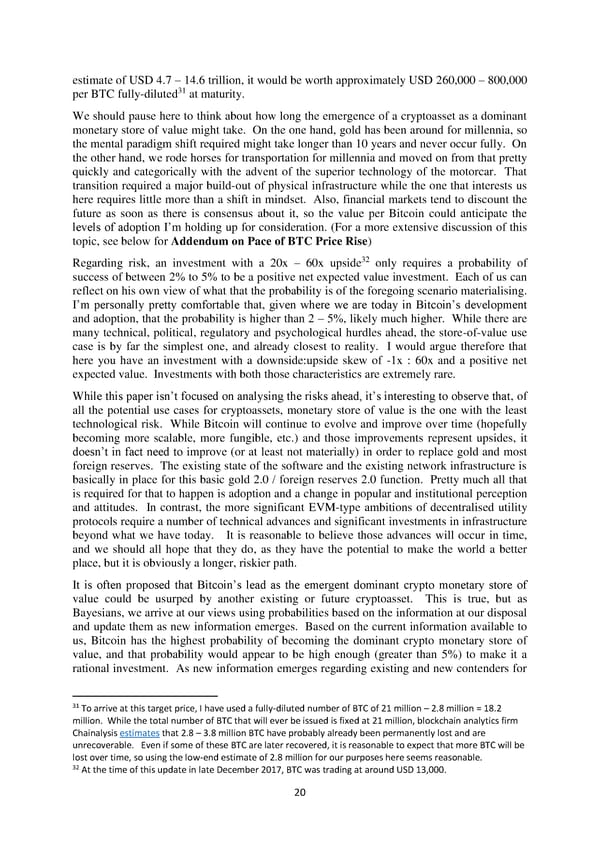estimate of USD 4.7 – 14.6 trillion, it would be worth approximately USD 260,000 – 800,000 per BTC fully-diluted31 at maturity. We should pause here to think about how long the emergence of a cryptoasset as a dominant monetary store of value might take. On the one hand, gold has been around for millennia, so the mental paradigm shift required might take longer than 10 years and never occur fully. On the other hand, we rode horses for transportation for millennia and moved on from that pretty quickly and categorically with the advent of the superior technology of the motorcar. That transition required a major build-out of physical infrastructure while the one that interests us here requires little more than a shift in mindset. Also, financial markets tend to discount the future as soon as there is consensus about it, so the value per Bitcoin could anticipate the levels of adoption I’m holding up for consideration. (For a more extensive discussion of this topic, see below for Addendum on Pace of BTC Price Rise) 32 Regarding risk, an investment with a 20x – 60x upside only requires a probability of success of between 2% to 5% to be a positive net expected value investment. Each of us can reflect on his own view of what that the probability is of the foregoing scenario materialising. I’m personally pretty comfortable that, given where we are today in Bitcoin’s development and adoption, that the probability is higher than 2 – 5%, likely much higher. While there are many technical, political, regulatory and psychological hurdles ahead, the store-of-value use case is by far the simplest one, and already closest to reality. I would argue therefore that here you have an investment with a downside:upside skew of -1x : 60x and a positive net expected value. Investments with both those characteristics are extremely rare. While this paper isn’t focused on analysing the risks ahead, it’s interesting to observe that, of all the potential use cases for cryptoassets, monetary store of value is the one with the least technological risk. While Bitcoin will continue to evolve and improve over time (hopefully becoming more scalable, more fungible, etc.) and those improvements represent upsides, it doesn’t in fact need to improve (or at least not materially) in order to replace gold and most foreign reserves. The existing state of the software and the existing network infrastructure is basically in place for this basic gold 2.0 / foreign reserves 2.0 function. Pretty much all that is required for that to happen is adoption and a change in popular and institutional perception and attitudes. In contrast, the more significant EVM-type ambitions of decentralised utility protocols require a number of technical advances and significant investments in infrastructure beyond what we have today. It is reasonable to believe those advances will occur in time, and we should all hope that they do, as they have the potential to make the world a better place, but it is obviously a longer, riskier path. It is often proposed that Bitcoin’s lead as the emergent dominant crypto monetary store of value could be usurped by another existing or future cryptoasset. This is true, but as Bayesians, we arrive at our views using probabilities based on the information at our disposal and update them as new information emerges. Based on the current information available to us, Bitcoin has the highest probability of becoming the dominant crypto monetary store of value, and that probability would appear to be high enough (greater than 5%) to make it a rational investment. As new information emerges regarding existing and new contenders for 31 To arrive at this target price, I have used a fully-diluted number of BTC of 21 million – 2.8 million = 18.2 million. While the total number of BTC that will ever be issued is fixed at 21 million, blockchain analytics firm Chainalysis estimates that 2.8 – 3.8 million BTC have probably already been permanently lost and are unrecoverable. Even if some of these BTC are later recovered, it is reasonable to expect that more BTC will be lost over time, so using the low-end estimate of 2.8 million for our purposes here seems reasonable. 32 At the time of this update in late December 2017, BTC was trading at around USD 13,000. 20
 Investor’s Take on Cryptoassets by John Pfeffer Page 19 Page 21
Investor’s Take on Cryptoassets by John Pfeffer Page 19 Page 21